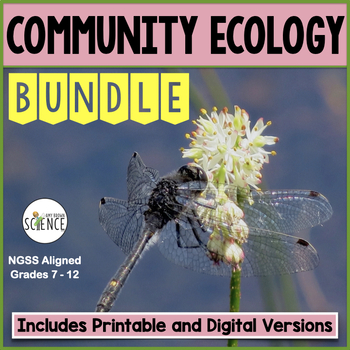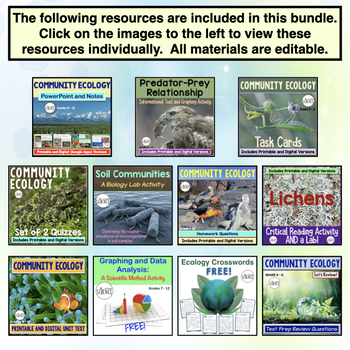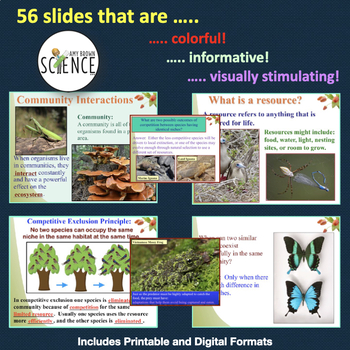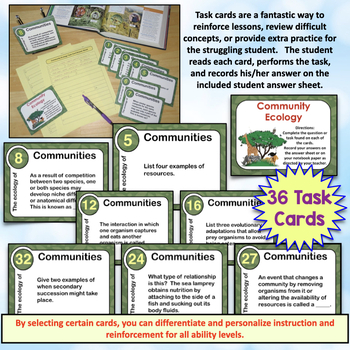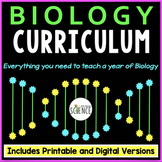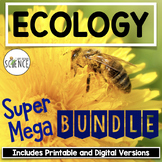Community Ecology Unit - Habitats and Communities, Ecological Relationships
- Zip
- Google Apps™

What educators are saying
Products in this Bundle (11)
showing 1-5 of 11 products
Bonus
Also included in
- This NO PREP, PRINTABLE, EDITABLE, AND DIGITAL Biology Curriculum contains everything you need for an entire year of Biology! For less than $3 a day, you can save your time, energy, and sanity. Each of the 20 Complete Units includes a teaching PowerPoint presentation, notes, labs, homework assignmenPrice $525.00Original Price $988.18Save $463.18
- All of my ecology and environmental science resources (6 ecology unit bundles) are included in this one Super-Mega-Bundle! This mega-bundle includes all of the PowerPoints, notes, labs, task cards, homework assignments, review games, quizzes, activities, and unit tests that you need to teach a compPrice $178.00Original Price $252.64Save $74.64
Description
This printable, editable, and digital bundle of resources on Community Ecology covers community interactions, such as competition, symbiosis, predator-prey relationships, ecological disturbances and succession. Please complete list of topics below. This bundle includes everything you need to teach a unit on community ecology to your life science or biology students. Resources include a Powerpoint presentation packed with colorful and interesting photographs, homework/study guide, 2 labs, a set of task cards, 2 graphing and informational text activities, 2 short quizzes, crossword puzzle, test prep review questions, and a final unit test.
From the engaging PowerPoint to the final unit test, this bundle contains loads of NO PREP materials that are ready to be used with your students. Many of the resources in this bundle are available in paperless digital formats for use in Google Drive, Google Classroom, Microsoft OneDrive, or similar.
What is included in this bundle? ( Items marked with ** have both printable and digital versions.)
- Community Ecology PowerPoint with Notes for Teacher and Student **
- Community Ecology Task Cards **
- Community Ecology Quiz Set of 2 **
- Lab: Soil Communities
- Lichens: Informational Text, Critical Reading and Lab Activity **
- Community Ecology REVIEW Powerpoint of 50 Questions/Answers
- Community Ecology Homework and Study Guide **
- Community Ecology Unit Test **
- Predator Prey Informational Text and Graphing Activity **
- Graphing and Data Analysis Activity on the Symbiotic Relationships of Mycorrhizae **
- Ecology Crossword Puzzles
Teacher Guide containing tips for implementing the resources, suggestions for sequencing, and alignment to NGSS standards is also included.
Complete Teacher Answer Keys are included for each resource.
Topics covered in this lesson are:
- Community Interactions: Definition of community, types of community interactions such as competition, predation, symbiosis, mutualism, commensalism, and parasitism.
- Competition: Definition of competition, definition of resource, the competitive exclusion principle, character displacement, many examples, resource partitioning, the result of organisms having identical niches.
- Predation: Definition, examples, predator, prey, the role of natural selection, adaptations found in predators, adaptations found in prey, mimicry, adaptations found in plants and herbivores.
- Symbiosis: Definition of symbiosis, types of symbiosis, mutualism, commensalism, parasitism, many examples of each.
- Properties of Communities: Species richness and diversity, definition of species richness, definition of species diversity, the species-area effect, the result of habitat destruction.
- Succession: Disturbances, definition and examples of disturbances, definition of succession, types of succession, primary succession, examples of primary succession, secondary succession, examples of secondary succession, pioneer species, climax communities.
- Succession in a Marine Ecosystem: A Whale-Fall Community.
The PowerPoint consists of 56 slides that are colorful, informative and visually stimulating. Pictures and diagrams are included that will greatly enhance your instruction to your students. This product also includes a set of notes for the teacher and a set of notes for the student. The students get an outline of the notes that they fill in as the PowerPoint lesson is being presented.
This teaching bundle is appropriate for all biology students in grades 8 - 12.
Related Resources Include:
Introduction to Ecology PowerPoint with Notes for Teacher and Student
Population Ecology PowerPoint with Notes for Teacher and Student
Ecosystems and the Biosphere: Biomes of the World PowerPoint and Notes
Humans Impact on the Environment PowerPoint and Notes
For updates about sales and new products, please follow my store:

